Business Strategy Analysis and Recommendations for Toyota
VerifiedAdded on 2020/01/07
|18
|5304
|37
Report
AI Summary
This report provides a comprehensive analysis of Toyota's business strategy. It begins with an introduction to strategic contexts, terminologies, and planning techniques, including the BCG and Ansoff matrices. Task 2 focuses on organizational and environmental audits using SWOT and PEST analyses, respectively, along with stakeholder analyses to assess Toyota's current position and external factors impacting its operations. The report then identifies appropriate and future strategies for Toyota. Finally, it discusses the roles, responsibilities, and resources required for strategy implementation, including monitoring targets and timescales. The report aims to provide insights into Toyota's strategic management, helping readers understand the implications of internal and external changes on the firm and build strategies to minimize their impact.
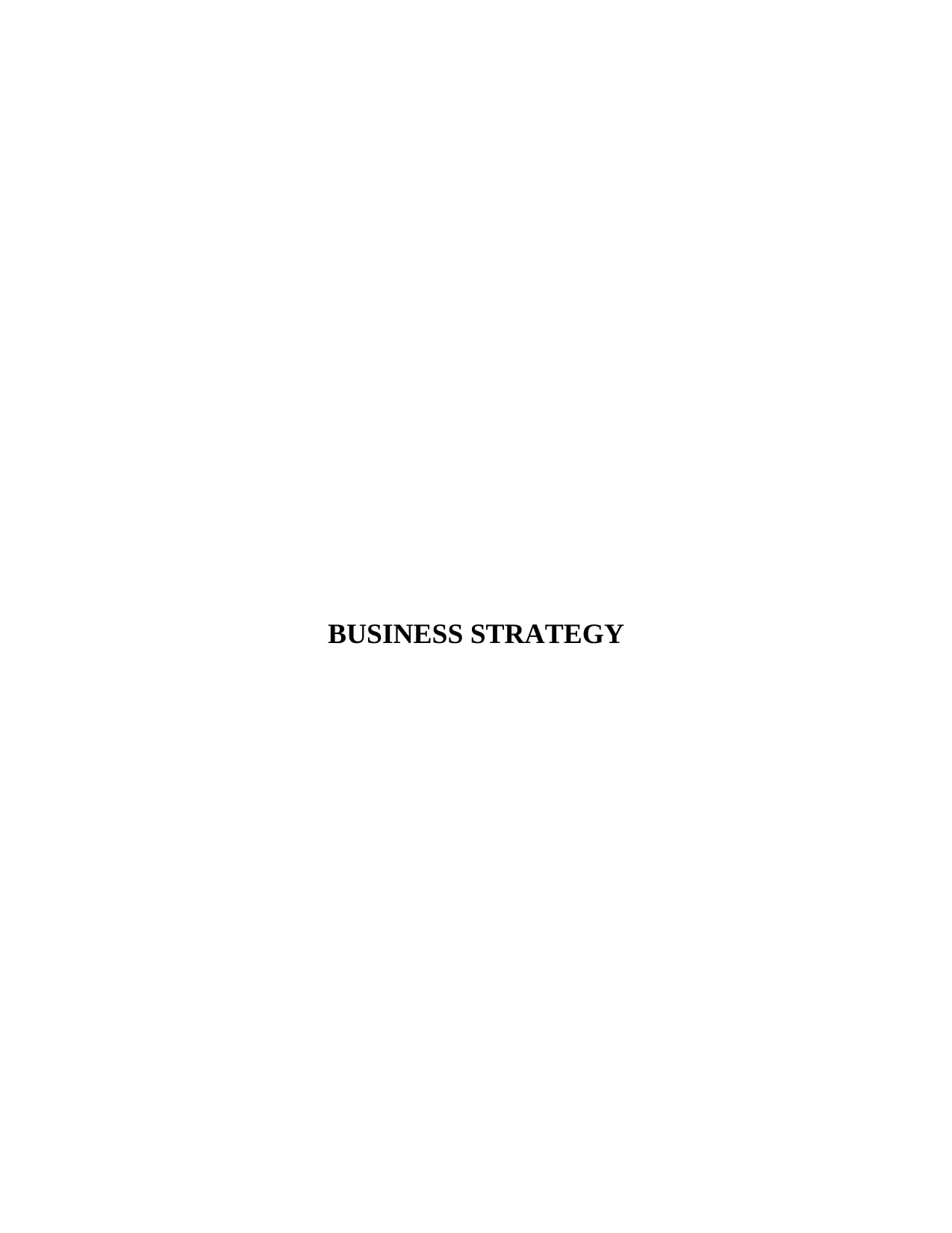
BUSINESS STRATEGY
Paraphrase This Document
Need a fresh take? Get an instant paraphrase of this document with our AI Paraphraser
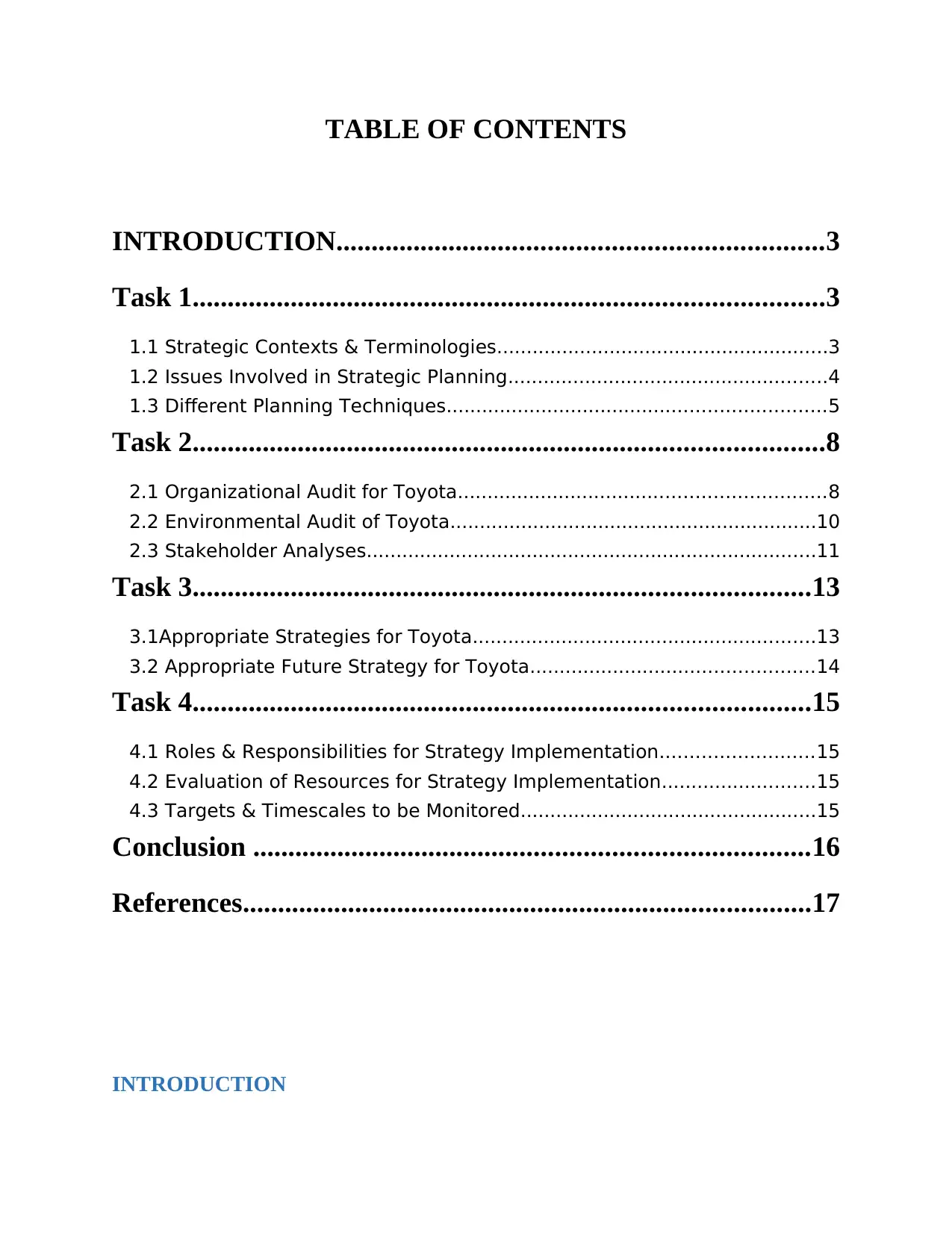
TABLE OF CONTENTS
INTRODUCTION.....................................................................3
Task 1..........................................................................................3
1.1 Strategic Contexts & Terminologies........................................................3
1.2 Issues Involved in Strategic Planning......................................................4
1.3 Different Planning Techniques................................................................5
Task 2..........................................................................................8
2.1 Organizational Audit for Toyota..............................................................8
2.2 Environmental Audit of Toyota..............................................................10
2.3 Stakeholder Analyses............................................................................11
Task 3........................................................................................13
3.1Appropriate Strategies for Toyota..........................................................13
3.2 Appropriate Future Strategy for Toyota................................................14
Task 4........................................................................................15
4.1 Roles & Responsibilities for Strategy Implementation..........................15
4.2 Evaluation of Resources for Strategy Implementation..........................15
4.3 Targets & Timescales to be Monitored..................................................15
Conclusion ...............................................................................16
References.................................................................................17
INTRODUCTION
INTRODUCTION.....................................................................3
Task 1..........................................................................................3
1.1 Strategic Contexts & Terminologies........................................................3
1.2 Issues Involved in Strategic Planning......................................................4
1.3 Different Planning Techniques................................................................5
Task 2..........................................................................................8
2.1 Organizational Audit for Toyota..............................................................8
2.2 Environmental Audit of Toyota..............................................................10
2.3 Stakeholder Analyses............................................................................11
Task 3........................................................................................13
3.1Appropriate Strategies for Toyota..........................................................13
3.2 Appropriate Future Strategy for Toyota................................................14
Task 4........................................................................................15
4.1 Roles & Responsibilities for Strategy Implementation..........................15
4.2 Evaluation of Resources for Strategy Implementation..........................15
4.3 Targets & Timescales to be Monitored..................................................15
Conclusion ...............................................................................16
References.................................................................................17
INTRODUCTION
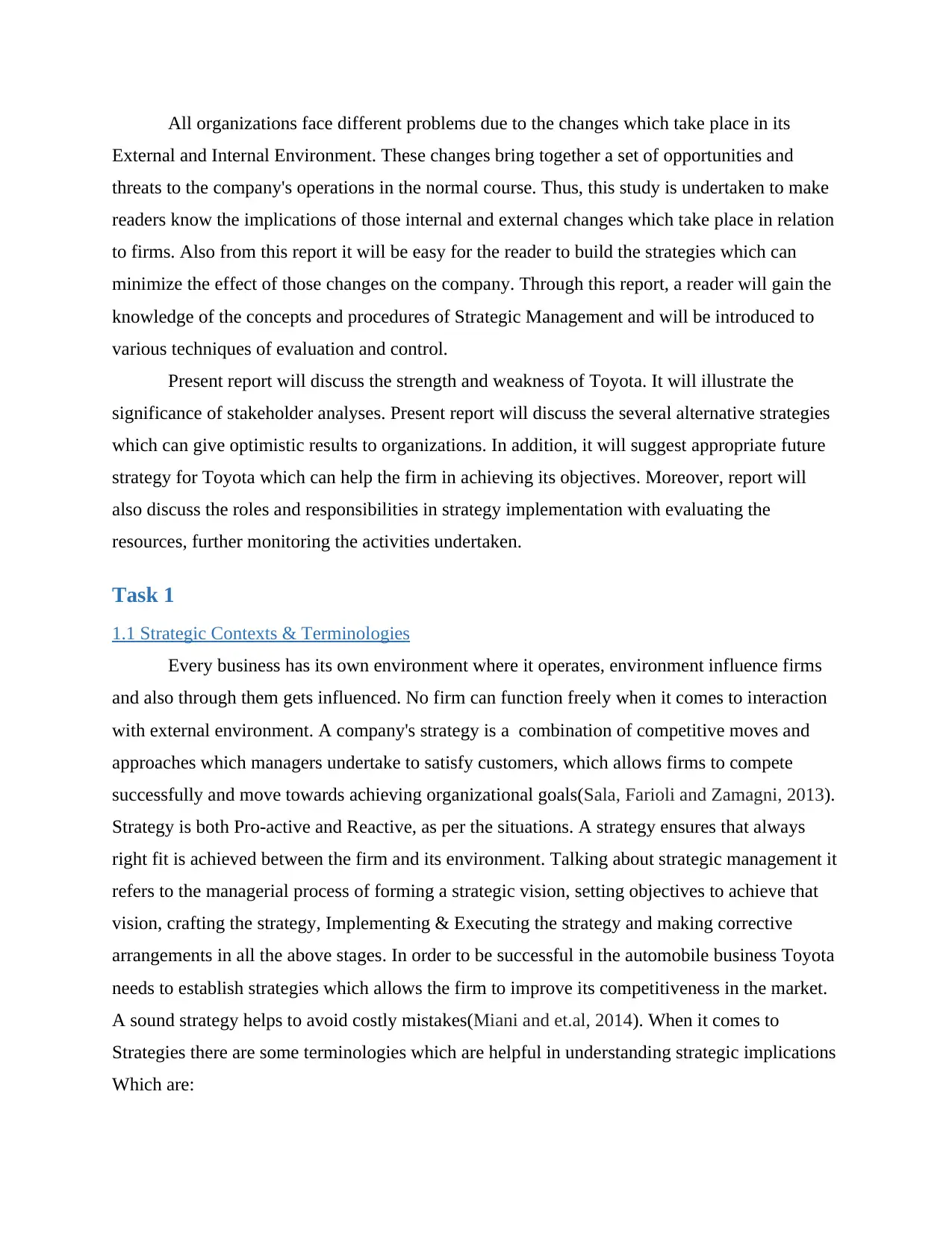
All organizations face different problems due to the changes which take place in its
External and Internal Environment. These changes bring together a set of opportunities and
threats to the company's operations in the normal course. Thus, this study is undertaken to make
readers know the implications of those internal and external changes which take place in relation
to firms. Also from this report it will be easy for the reader to build the strategies which can
minimize the effect of those changes on the company. Through this report, a reader will gain the
knowledge of the concepts and procedures of Strategic Management and will be introduced to
various techniques of evaluation and control.
Present report will discuss the strength and weakness of Toyota. It will illustrate the
significance of stakeholder analyses. Present report will discuss the several alternative strategies
which can give optimistic results to organizations. In addition, it will suggest appropriate future
strategy for Toyota which can help the firm in achieving its objectives. Moreover, report will
also discuss the roles and responsibilities in strategy implementation with evaluating the
resources, further monitoring the activities undertaken.
Task 1
1.1 Strategic Contexts & Terminologies
Every business has its own environment where it operates, environment influence firms
and also through them gets influenced. No firm can function freely when it comes to interaction
with external environment. A company's strategy is a combination of competitive moves and
approaches which managers undertake to satisfy customers, which allows firms to compete
successfully and move towards achieving organizational goals(Sala, Farioli and Zamagni, 2013).
Strategy is both Pro-active and Reactive, as per the situations. A strategy ensures that always
right fit is achieved between the firm and its environment. Talking about strategic management it
refers to the managerial process of forming a strategic vision, setting objectives to achieve that
vision, crafting the strategy, Implementing & Executing the strategy and making corrective
arrangements in all the above stages. In order to be successful in the automobile business Toyota
needs to establish strategies which allows the firm to improve its competitiveness in the market.
A sound strategy helps to avoid costly mistakes(Miani and et.al, 2014). When it comes to
Strategies there are some terminologies which are helpful in understanding strategic implications
Which are:
External and Internal Environment. These changes bring together a set of opportunities and
threats to the company's operations in the normal course. Thus, this study is undertaken to make
readers know the implications of those internal and external changes which take place in relation
to firms. Also from this report it will be easy for the reader to build the strategies which can
minimize the effect of those changes on the company. Through this report, a reader will gain the
knowledge of the concepts and procedures of Strategic Management and will be introduced to
various techniques of evaluation and control.
Present report will discuss the strength and weakness of Toyota. It will illustrate the
significance of stakeholder analyses. Present report will discuss the several alternative strategies
which can give optimistic results to organizations. In addition, it will suggest appropriate future
strategy for Toyota which can help the firm in achieving its objectives. Moreover, report will
also discuss the roles and responsibilities in strategy implementation with evaluating the
resources, further monitoring the activities undertaken.
Task 1
1.1 Strategic Contexts & Terminologies
Every business has its own environment where it operates, environment influence firms
and also through them gets influenced. No firm can function freely when it comes to interaction
with external environment. A company's strategy is a combination of competitive moves and
approaches which managers undertake to satisfy customers, which allows firms to compete
successfully and move towards achieving organizational goals(Sala, Farioli and Zamagni, 2013).
Strategy is both Pro-active and Reactive, as per the situations. A strategy ensures that always
right fit is achieved between the firm and its environment. Talking about strategic management it
refers to the managerial process of forming a strategic vision, setting objectives to achieve that
vision, crafting the strategy, Implementing & Executing the strategy and making corrective
arrangements in all the above stages. In order to be successful in the automobile business Toyota
needs to establish strategies which allows the firm to improve its competitiveness in the market.
A sound strategy helps to avoid costly mistakes(Miani and et.al, 2014). When it comes to
Strategies there are some terminologies which are helpful in understanding strategic implications
Which are:
⊘ This is a preview!⊘
Do you want full access?
Subscribe today to unlock all pages.

Trusted by 1+ million students worldwide
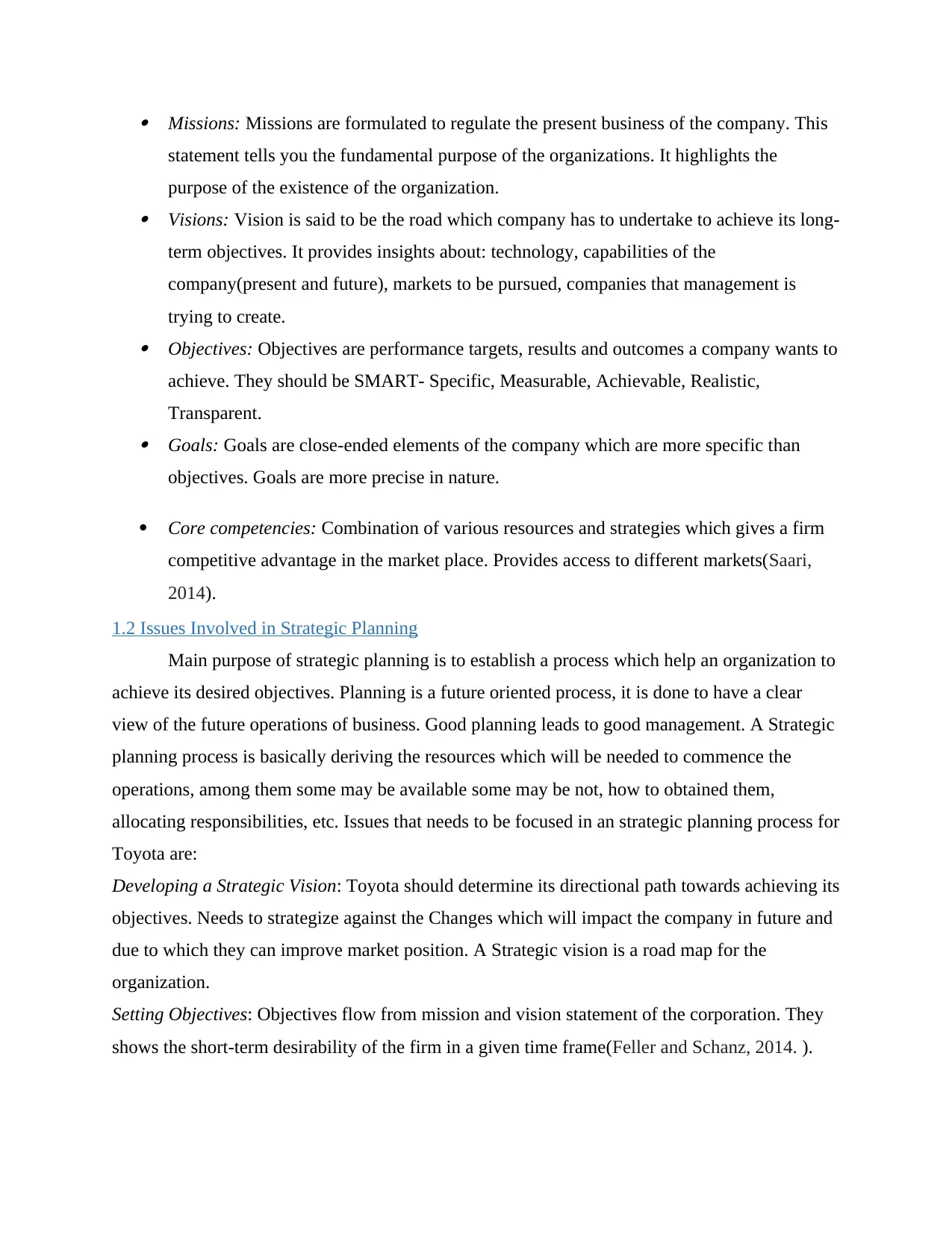
Missions: Missions are formulated to regulate the present business of the company. This
statement tells you the fundamental purpose of the organizations. It highlights the
purpose of the existence of the organization. Visions: Vision is said to be the road which company has to undertake to achieve its long-
term objectives. It provides insights about: technology, capabilities of the
company(present and future), markets to be pursued, companies that management is
trying to create. Objectives: Objectives are performance targets, results and outcomes a company wants to
achieve. They should be SMART- Specific, Measurable, Achievable, Realistic,
Transparent. Goals: Goals are close-ended elements of the company which are more specific than
objectives. Goals are more precise in nature.
Core competencies: Combination of various resources and strategies which gives a firm
competitive advantage in the market place. Provides access to different markets(Saari,
2014).
1.2 Issues Involved in Strategic Planning
Main purpose of strategic planning is to establish a process which help an organization to
achieve its desired objectives. Planning is a future oriented process, it is done to have a clear
view of the future operations of business. Good planning leads to good management. A Strategic
planning process is basically deriving the resources which will be needed to commence the
operations, among them some may be available some may be not, how to obtained them,
allocating responsibilities, etc. Issues that needs to be focused in an strategic planning process for
Toyota are:
Developing a Strategic Vision: Toyota should determine its directional path towards achieving its
objectives. Needs to strategize against the Changes which will impact the company in future and
due to which they can improve market position. A Strategic vision is a road map for the
organization.
Setting Objectives: Objectives flow from mission and vision statement of the corporation. They
shows the short-term desirability of the firm in a given time frame(Feller and Schanz, 2014. ).
statement tells you the fundamental purpose of the organizations. It highlights the
purpose of the existence of the organization. Visions: Vision is said to be the road which company has to undertake to achieve its long-
term objectives. It provides insights about: technology, capabilities of the
company(present and future), markets to be pursued, companies that management is
trying to create. Objectives: Objectives are performance targets, results and outcomes a company wants to
achieve. They should be SMART- Specific, Measurable, Achievable, Realistic,
Transparent. Goals: Goals are close-ended elements of the company which are more specific than
objectives. Goals are more precise in nature.
Core competencies: Combination of various resources and strategies which gives a firm
competitive advantage in the market place. Provides access to different markets(Saari,
2014).
1.2 Issues Involved in Strategic Planning
Main purpose of strategic planning is to establish a process which help an organization to
achieve its desired objectives. Planning is a future oriented process, it is done to have a clear
view of the future operations of business. Good planning leads to good management. A Strategic
planning process is basically deriving the resources which will be needed to commence the
operations, among them some may be available some may be not, how to obtained them,
allocating responsibilities, etc. Issues that needs to be focused in an strategic planning process for
Toyota are:
Developing a Strategic Vision: Toyota should determine its directional path towards achieving its
objectives. Needs to strategize against the Changes which will impact the company in future and
due to which they can improve market position. A Strategic vision is a road map for the
organization.
Setting Objectives: Objectives flow from mission and vision statement of the corporation. They
shows the short-term desirability of the firm in a given time frame(Feller and Schanz, 2014. ).
Paraphrase This Document
Need a fresh take? Get an instant paraphrase of this document with our AI Paraphraser
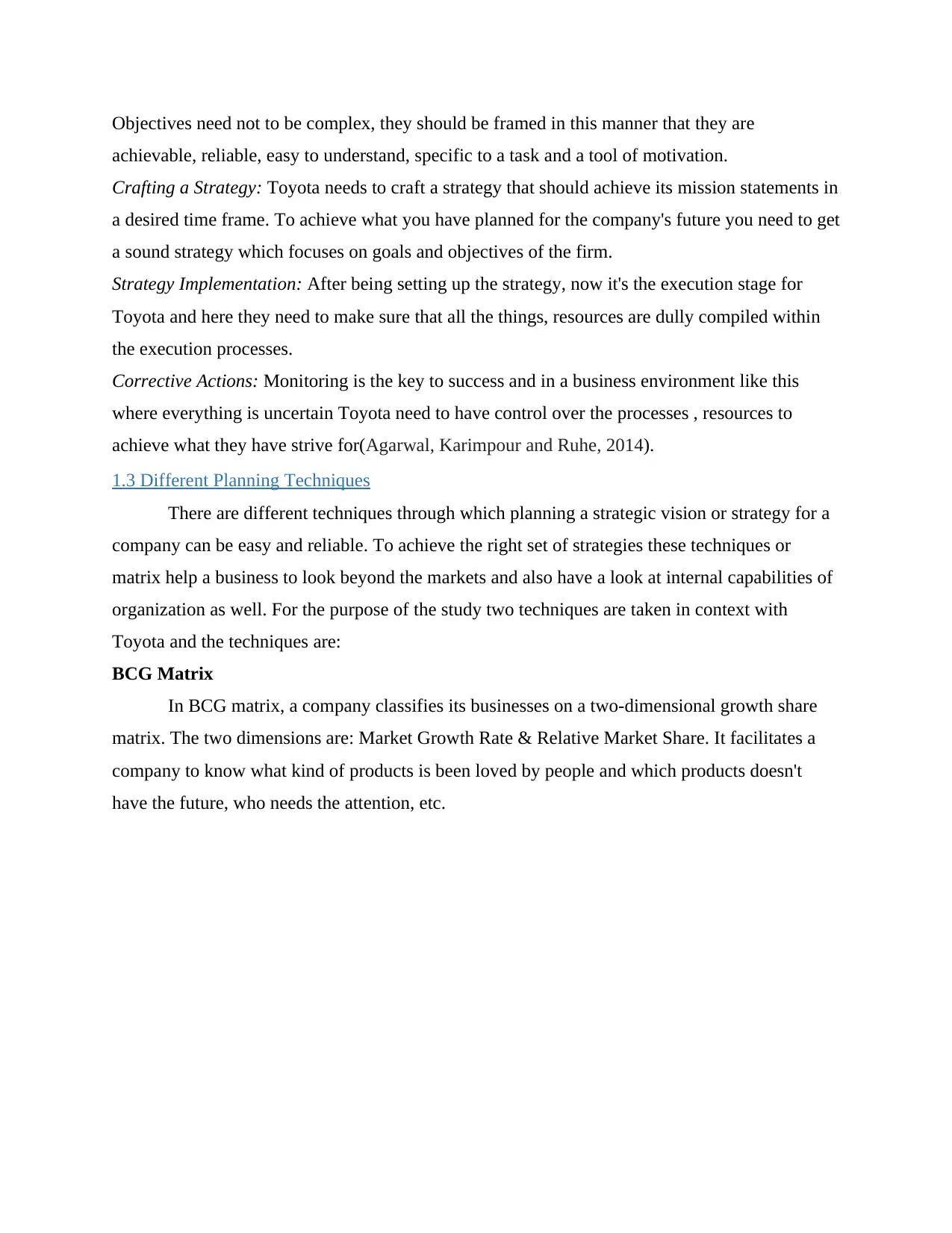
Objectives need not to be complex, they should be framed in this manner that they are
achievable, reliable, easy to understand, specific to a task and a tool of motivation.
Crafting a Strategy: Toyota needs to craft a strategy that should achieve its mission statements in
a desired time frame. To achieve what you have planned for the company's future you need to get
a sound strategy which focuses on goals and objectives of the firm.
Strategy Implementation: After being setting up the strategy, now it's the execution stage for
Toyota and here they need to make sure that all the things, resources are dully compiled within
the execution processes.
Corrective Actions: Monitoring is the key to success and in a business environment like this
where everything is uncertain Toyota need to have control over the processes , resources to
achieve what they have strive for(Agarwal, Karimpour and Ruhe, 2014).
1.3 Different Planning Techniques
There are different techniques through which planning a strategic vision or strategy for a
company can be easy and reliable. To achieve the right set of strategies these techniques or
matrix help a business to look beyond the markets and also have a look at internal capabilities of
organization as well. For the purpose of the study two techniques are taken in context with
Toyota and the techniques are:
BCG Matrix
In BCG matrix, a company classifies its businesses on a two-dimensional growth share
matrix. The two dimensions are: Market Growth Rate & Relative Market Share. It facilitates a
company to know what kind of products is been loved by people and which products doesn't
have the future, who needs the attention, etc.
achievable, reliable, easy to understand, specific to a task and a tool of motivation.
Crafting a Strategy: Toyota needs to craft a strategy that should achieve its mission statements in
a desired time frame. To achieve what you have planned for the company's future you need to get
a sound strategy which focuses on goals and objectives of the firm.
Strategy Implementation: After being setting up the strategy, now it's the execution stage for
Toyota and here they need to make sure that all the things, resources are dully compiled within
the execution processes.
Corrective Actions: Monitoring is the key to success and in a business environment like this
where everything is uncertain Toyota need to have control over the processes , resources to
achieve what they have strive for(Agarwal, Karimpour and Ruhe, 2014).
1.3 Different Planning Techniques
There are different techniques through which planning a strategic vision or strategy for a
company can be easy and reliable. To achieve the right set of strategies these techniques or
matrix help a business to look beyond the markets and also have a look at internal capabilities of
organization as well. For the purpose of the study two techniques are taken in context with
Toyota and the techniques are:
BCG Matrix
In BCG matrix, a company classifies its businesses on a two-dimensional growth share
matrix. The two dimensions are: Market Growth Rate & Relative Market Share. It facilitates a
company to know what kind of products is been loved by people and which products doesn't
have the future, who needs the attention, etc.
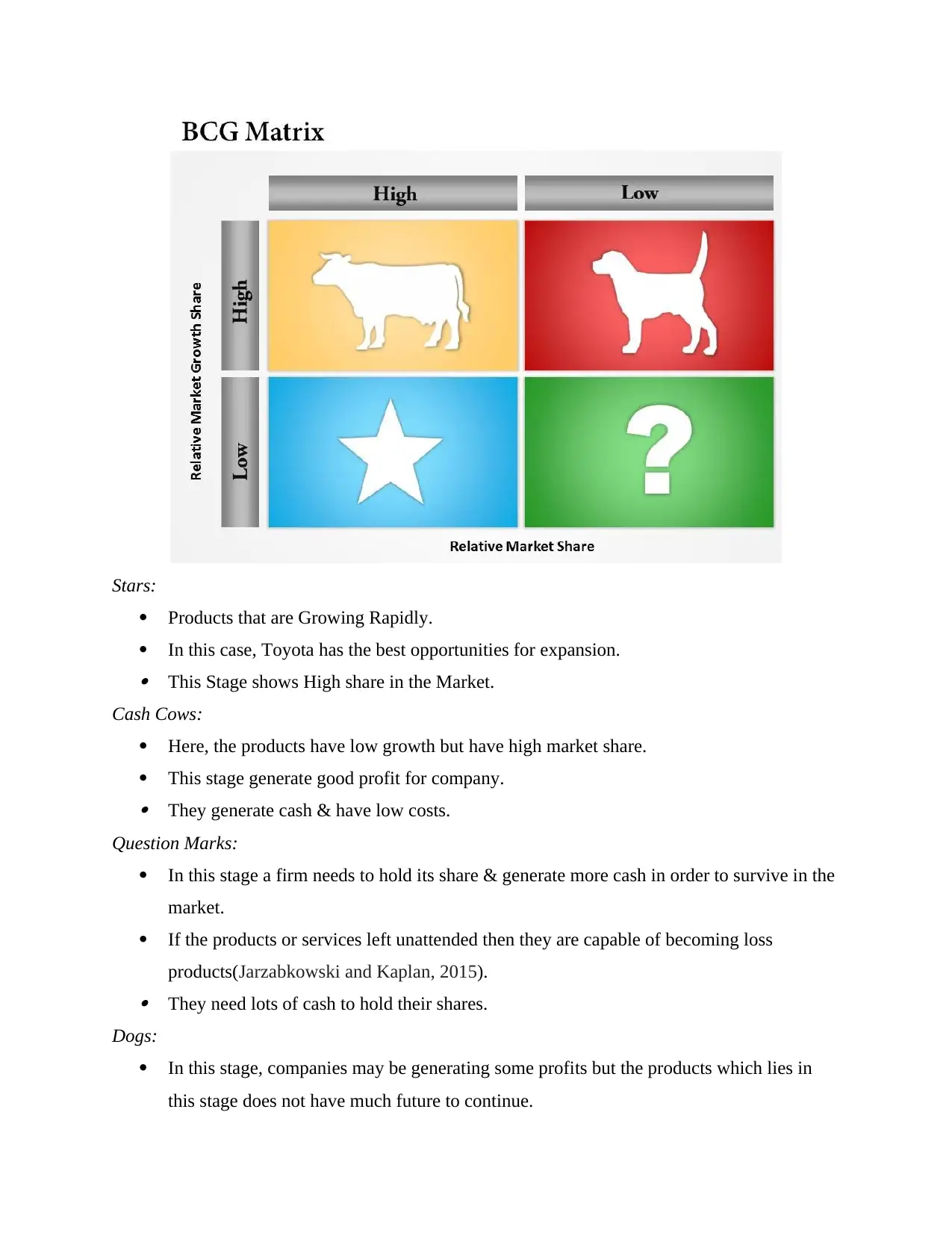
Stars:
Products that are Growing Rapidly.
In this case, Toyota has the best opportunities for expansion. This Stage shows High share in the Market.
Cash Cows:
Here, the products have low growth but have high market share.
This stage generate good profit for company. They generate cash & have low costs.
Question Marks:
In this stage a firm needs to hold its share & generate more cash in order to survive in the
market.
If the products or services left unattended then they are capable of becoming loss
products(Jarzabkowski and Kaplan, 2015). They need lots of cash to hold their shares.
Dogs:
In this stage, companies may be generating some profits but the products which lies in
this stage does not have much future to continue.
Products that are Growing Rapidly.
In this case, Toyota has the best opportunities for expansion. This Stage shows High share in the Market.
Cash Cows:
Here, the products have low growth but have high market share.
This stage generate good profit for company. They generate cash & have low costs.
Question Marks:
In this stage a firm needs to hold its share & generate more cash in order to survive in the
market.
If the products or services left unattended then they are capable of becoming loss
products(Jarzabkowski and Kaplan, 2015). They need lots of cash to hold their shares.
Dogs:
In this stage, companies may be generating some profits but the products which lies in
this stage does not have much future to continue.
⊘ This is a preview!⊘
Do you want full access?
Subscribe today to unlock all pages.

Trusted by 1+ million students worldwide
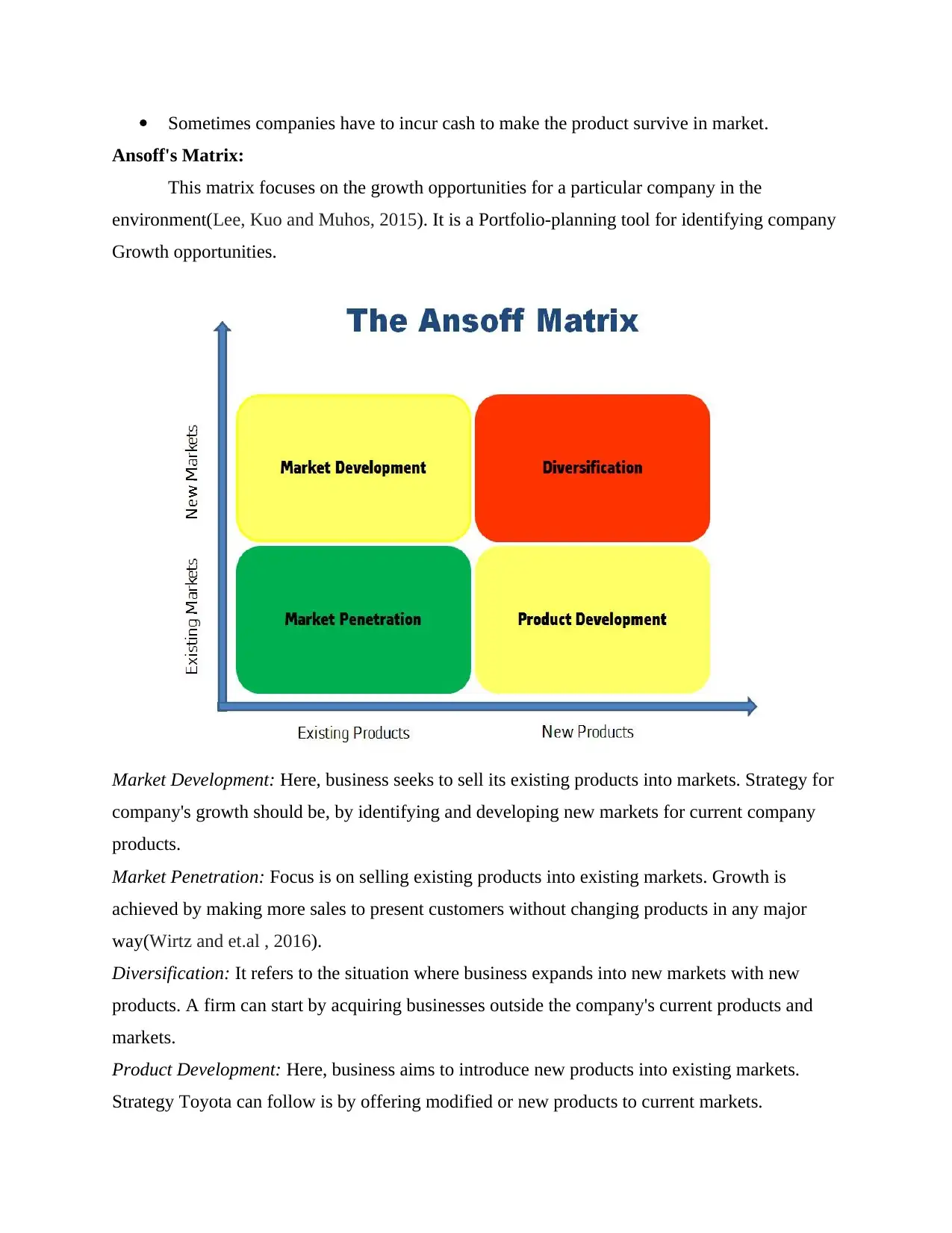
Sometimes companies have to incur cash to make the product survive in market.
Ansoff's Matrix:
This matrix focuses on the growth opportunities for a particular company in the
environment(Lee, Kuo and Muhos, 2015). It is a Portfolio-planning tool for identifying company
Growth opportunities.
Market Development: Here, business seeks to sell its existing products into markets. Strategy for
company's growth should be, by identifying and developing new markets for current company
products.
Market Penetration: Focus is on selling existing products into existing markets. Growth is
achieved by making more sales to present customers without changing products in any major
way(Wirtz and et.al , 2016).
Diversification: It refers to the situation where business expands into new markets with new
products. A firm can start by acquiring businesses outside the company's current products and
markets.
Product Development: Here, business aims to introduce new products into existing markets.
Strategy Toyota can follow is by offering modified or new products to current markets.
Ansoff's Matrix:
This matrix focuses on the growth opportunities for a particular company in the
environment(Lee, Kuo and Muhos, 2015). It is a Portfolio-planning tool for identifying company
Growth opportunities.
Market Development: Here, business seeks to sell its existing products into markets. Strategy for
company's growth should be, by identifying and developing new markets for current company
products.
Market Penetration: Focus is on selling existing products into existing markets. Growth is
achieved by making more sales to present customers without changing products in any major
way(Wirtz and et.al , 2016).
Diversification: It refers to the situation where business expands into new markets with new
products. A firm can start by acquiring businesses outside the company's current products and
markets.
Product Development: Here, business aims to introduce new products into existing markets.
Strategy Toyota can follow is by offering modified or new products to current markets.
Paraphrase This Document
Need a fresh take? Get an instant paraphrase of this document with our AI Paraphraser
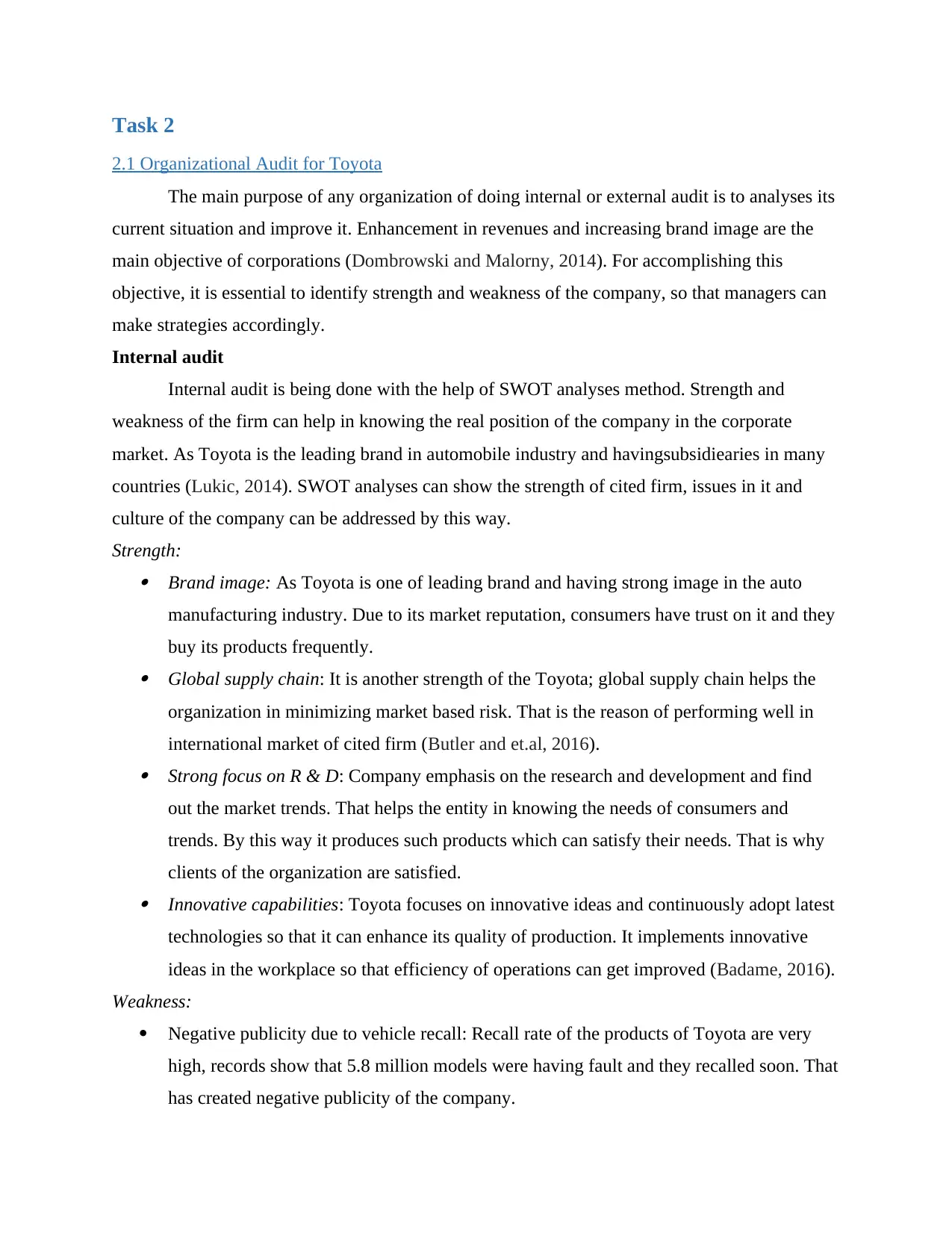
Task 2
2.1 Organizational Audit for Toyota
The main purpose of any organization of doing internal or external audit is to analyses its
current situation and improve it. Enhancement in revenues and increasing brand image are the
main objective of corporations (Dombrowski and Malorny, 2014). For accomplishing this
objective, it is essential to identify strength and weakness of the company, so that managers can
make strategies accordingly.
Internal audit
Internal audit is being done with the help of SWOT analyses method. Strength and
weakness of the firm can help in knowing the real position of the company in the corporate
market. As Toyota is the leading brand in automobile industry and havingsubsidiearies in many
countries (Lukic, 2014). SWOT analyses can show the strength of cited firm, issues in it and
culture of the company can be addressed by this way.
Strength: Brand image: As Toyota is one of leading brand and having strong image in the auto
manufacturing industry. Due to its market reputation, consumers have trust on it and they
buy its products frequently. Global supply chain: It is another strength of the Toyota; global supply chain helps the
organization in minimizing market based risk. That is the reason of performing well in
international market of cited firm (Butler and et.al, 2016). Strong focus on R & D: Company emphasis on the research and development and find
out the market trends. That helps the entity in knowing the needs of consumers and
trends. By this way it produces such products which can satisfy their needs. That is why
clients of the organization are satisfied. Innovative capabilities: Toyota focuses on innovative ideas and continuously adopt latest
technologies so that it can enhance its quality of production. It implements innovative
ideas in the workplace so that efficiency of operations can get improved (Badame, 2016).
Weakness:
Negative publicity due to vehicle recall: Recall rate of the products of Toyota are very
high, records show that 5.8 million models were having fault and they recalled soon. That
has created negative publicity of the company.
2.1 Organizational Audit for Toyota
The main purpose of any organization of doing internal or external audit is to analyses its
current situation and improve it. Enhancement in revenues and increasing brand image are the
main objective of corporations (Dombrowski and Malorny, 2014). For accomplishing this
objective, it is essential to identify strength and weakness of the company, so that managers can
make strategies accordingly.
Internal audit
Internal audit is being done with the help of SWOT analyses method. Strength and
weakness of the firm can help in knowing the real position of the company in the corporate
market. As Toyota is the leading brand in automobile industry and havingsubsidiearies in many
countries (Lukic, 2014). SWOT analyses can show the strength of cited firm, issues in it and
culture of the company can be addressed by this way.
Strength: Brand image: As Toyota is one of leading brand and having strong image in the auto
manufacturing industry. Due to its market reputation, consumers have trust on it and they
buy its products frequently. Global supply chain: It is another strength of the Toyota; global supply chain helps the
organization in minimizing market based risk. That is the reason of performing well in
international market of cited firm (Butler and et.al, 2016). Strong focus on R & D: Company emphasis on the research and development and find
out the market trends. That helps the entity in knowing the needs of consumers and
trends. By this way it produces such products which can satisfy their needs. That is why
clients of the organization are satisfied. Innovative capabilities: Toyota focuses on innovative ideas and continuously adopt latest
technologies so that it can enhance its quality of production. It implements innovative
ideas in the workplace so that efficiency of operations can get improved (Badame, 2016).
Weakness:
Negative publicity due to vehicle recall: Recall rate of the products of Toyota are very
high, records show that 5.8 million models were having fault and they recalled soon. That
has created negative publicity of the company.
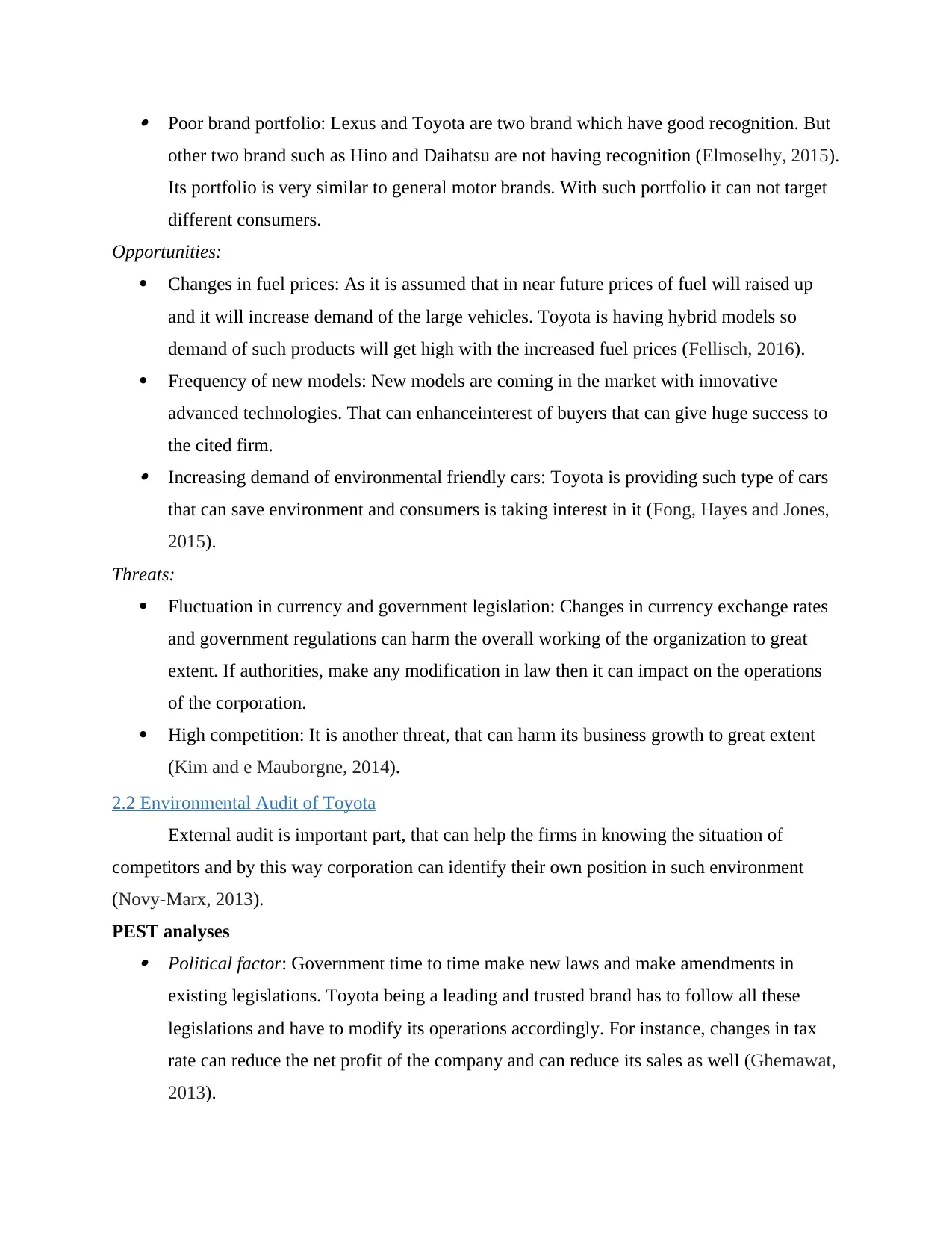
Poor brand portfolio: Lexus and Toyota are two brand which have good recognition. But
other two brand such as Hino and Daihatsu are not having recognition (Elmoselhy, 2015).
Its portfolio is very similar to general motor brands. With such portfolio it can not target
different consumers.
Opportunities:
Changes in fuel prices: As it is assumed that in near future prices of fuel will raised up
and it will increase demand of the large vehicles. Toyota is having hybrid models so
demand of such products will get high with the increased fuel prices (Fellisch, 2016).
Frequency of new models: New models are coming in the market with innovative
advanced technologies. That can enhanceinterest of buyers that can give huge success to
the cited firm. Increasing demand of environmental friendly cars: Toyota is providing such type of cars
that can save environment and consumers is taking interest in it (Fong, Hayes and Jones,
2015).
Threats:
Fluctuation in currency and government legislation: Changes in currency exchange rates
and government regulations can harm the overall working of the organization to great
extent. If authorities, make any modification in law then it can impact on the operations
of the corporation.
High competition: It is another threat, that can harm its business growth to great extent
(Kim and e Mauborgne, 2014).
2.2 Environmental Audit of Toyota
External audit is important part, that can help the firms in knowing the situation of
competitors and by this way corporation can identify their own position in such environment
(Novy-Marx, 2013).
PEST analyses Political factor: Government time to time make new laws and make amendments in
existing legislations. Toyota being a leading and trusted brand has to follow all these
legislations and have to modify its operations accordingly. For instance, changes in tax
rate can reduce the net profit of the company and can reduce its sales as well (Ghemawat,
2013).
other two brand such as Hino and Daihatsu are not having recognition (Elmoselhy, 2015).
Its portfolio is very similar to general motor brands. With such portfolio it can not target
different consumers.
Opportunities:
Changes in fuel prices: As it is assumed that in near future prices of fuel will raised up
and it will increase demand of the large vehicles. Toyota is having hybrid models so
demand of such products will get high with the increased fuel prices (Fellisch, 2016).
Frequency of new models: New models are coming in the market with innovative
advanced technologies. That can enhanceinterest of buyers that can give huge success to
the cited firm. Increasing demand of environmental friendly cars: Toyota is providing such type of cars
that can save environment and consumers is taking interest in it (Fong, Hayes and Jones,
2015).
Threats:
Fluctuation in currency and government legislation: Changes in currency exchange rates
and government regulations can harm the overall working of the organization to great
extent. If authorities, make any modification in law then it can impact on the operations
of the corporation.
High competition: It is another threat, that can harm its business growth to great extent
(Kim and e Mauborgne, 2014).
2.2 Environmental Audit of Toyota
External audit is important part, that can help the firms in knowing the situation of
competitors and by this way corporation can identify their own position in such environment
(Novy-Marx, 2013).
PEST analyses Political factor: Government time to time make new laws and make amendments in
existing legislations. Toyota being a leading and trusted brand has to follow all these
legislations and have to modify its operations accordingly. For instance, changes in tax
rate can reduce the net profit of the company and can reduce its sales as well (Ghemawat,
2013).
⊘ This is a preview!⊘
Do you want full access?
Subscribe today to unlock all pages.

Trusted by 1+ million students worldwide
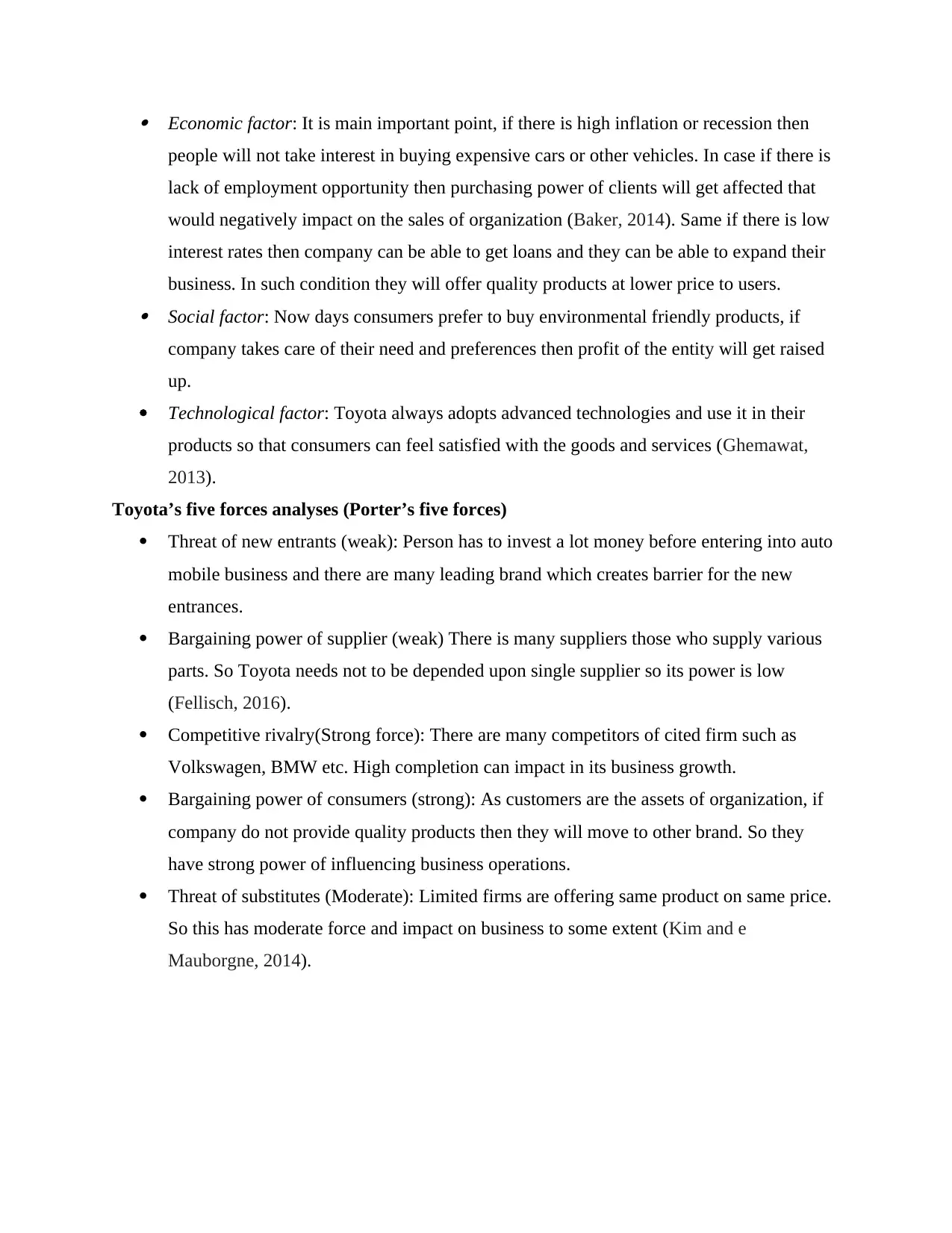
Economic factor: It is main important point, if there is high inflation or recession then
people will not take interest in buying expensive cars or other vehicles. In case if there is
lack of employment opportunity then purchasing power of clients will get affected that
would negatively impact on the sales of organization (Baker, 2014). Same if there is low
interest rates then company can be able to get loans and they can be able to expand their
business. In such condition they will offer quality products at lower price to users. Social factor: Now days consumers prefer to buy environmental friendly products, if
company takes care of their need and preferences then profit of the entity will get raised
up.
Technological factor: Toyota always adopts advanced technologies and use it in their
products so that consumers can feel satisfied with the goods and services (Ghemawat,
2013).
Toyota’s five forces analyses (Porter’s five forces)
Threat of new entrants (weak): Person has to invest a lot money before entering into auto
mobile business and there are many leading brand which creates barrier for the new
entrances.
Bargaining power of supplier (weak) There is many suppliers those who supply various
parts. So Toyota needs not to be depended upon single supplier so its power is low
(Fellisch, 2016).
Competitive rivalry(Strong force): There are many competitors of cited firm such as
Volkswagen, BMW etc. High completion can impact in its business growth.
Bargaining power of consumers (strong): As customers are the assets of organization, if
company do not provide quality products then they will move to other brand. So they
have strong power of influencing business operations.
Threat of substitutes (Moderate): Limited firms are offering same product on same price.
So this has moderate force and impact on business to some extent (Kim and e
Mauborgne, 2014).
people will not take interest in buying expensive cars or other vehicles. In case if there is
lack of employment opportunity then purchasing power of clients will get affected that
would negatively impact on the sales of organization (Baker, 2014). Same if there is low
interest rates then company can be able to get loans and they can be able to expand their
business. In such condition they will offer quality products at lower price to users. Social factor: Now days consumers prefer to buy environmental friendly products, if
company takes care of their need and preferences then profit of the entity will get raised
up.
Technological factor: Toyota always adopts advanced technologies and use it in their
products so that consumers can feel satisfied with the goods and services (Ghemawat,
2013).
Toyota’s five forces analyses (Porter’s five forces)
Threat of new entrants (weak): Person has to invest a lot money before entering into auto
mobile business and there are many leading brand which creates barrier for the new
entrances.
Bargaining power of supplier (weak) There is many suppliers those who supply various
parts. So Toyota needs not to be depended upon single supplier so its power is low
(Fellisch, 2016).
Competitive rivalry(Strong force): There are many competitors of cited firm such as
Volkswagen, BMW etc. High completion can impact in its business growth.
Bargaining power of consumers (strong): As customers are the assets of organization, if
company do not provide quality products then they will move to other brand. So they
have strong power of influencing business operations.
Threat of substitutes (Moderate): Limited firms are offering same product on same price.
So this has moderate force and impact on business to some extent (Kim and e
Mauborgne, 2014).
Paraphrase This Document
Need a fresh take? Get an instant paraphrase of this document with our AI Paraphraser
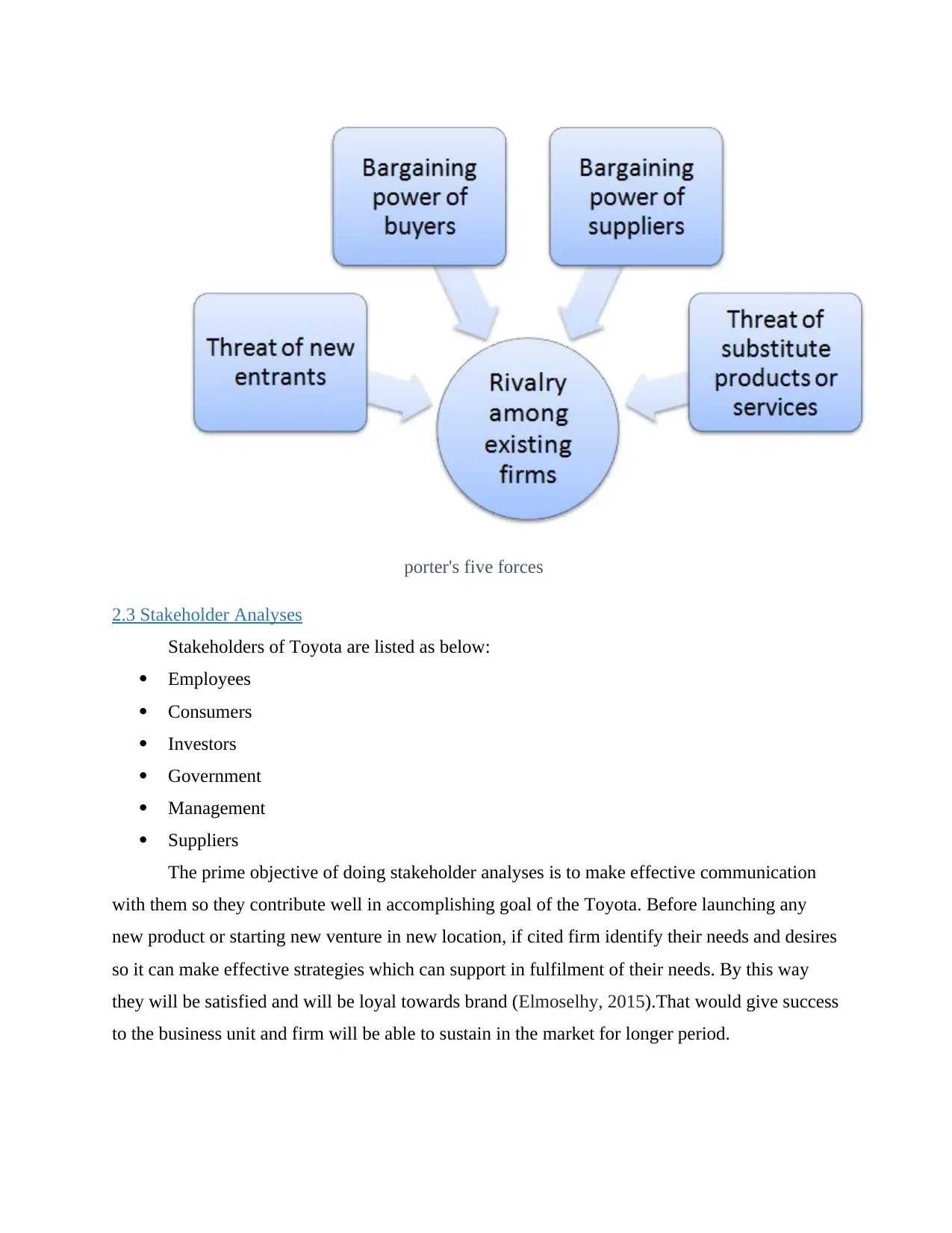
porter's five forces
2.3 Stakeholder Analyses
Stakeholders of Toyota are listed as below:
Employees
Consumers
Investors
Government
Management
Suppliers
The prime objective of doing stakeholder analyses is to make effective communication
with them so they contribute well in accomplishing goal of the Toyota. Before launching any
new product or starting new venture in new location, if cited firm identify their needs and desires
so it can make effective strategies which can support in fulfilment of their needs. By this way
they will be satisfied and will be loyal towards brand (Elmoselhy, 2015).That would give success
to the business unit and firm will be able to sustain in the market for longer period.
2.3 Stakeholder Analyses
Stakeholders of Toyota are listed as below:
Employees
Consumers
Investors
Government
Management
Suppliers
The prime objective of doing stakeholder analyses is to make effective communication
with them so they contribute well in accomplishing goal of the Toyota. Before launching any
new product or starting new venture in new location, if cited firm identify their needs and desires
so it can make effective strategies which can support in fulfilment of their needs. By this way
they will be satisfied and will be loyal towards brand (Elmoselhy, 2015).That would give success
to the business unit and firm will be able to sustain in the market for longer period.
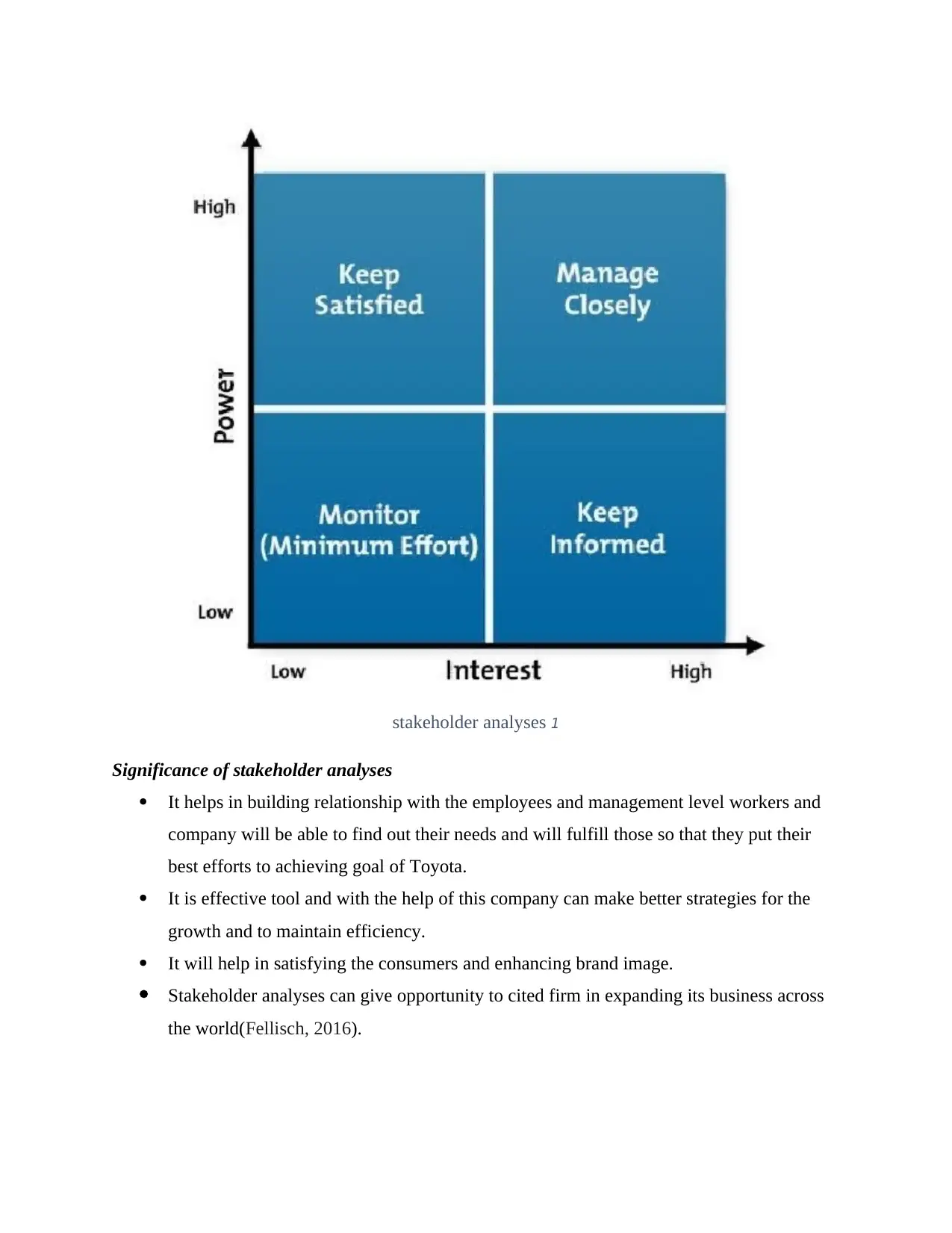
stakeholder analyses 1
Significance of stakeholder analyses
It helps in building relationship with the employees and management level workers and
company will be able to find out their needs and will fulfill those so that they put their
best efforts to achieving goal of Toyota.
It is effective tool and with the help of this company can make better strategies for the
growth and to maintain efficiency.
It will help in satisfying the consumers and enhancing brand image.
Stakeholder analyses can give opportunity to cited firm in expanding its business across
the world(Fellisch, 2016).
Significance of stakeholder analyses
It helps in building relationship with the employees and management level workers and
company will be able to find out their needs and will fulfill those so that they put their
best efforts to achieving goal of Toyota.
It is effective tool and with the help of this company can make better strategies for the
growth and to maintain efficiency.
It will help in satisfying the consumers and enhancing brand image.
Stakeholder analyses can give opportunity to cited firm in expanding its business across
the world(Fellisch, 2016).
⊘ This is a preview!⊘
Do you want full access?
Subscribe today to unlock all pages.

Trusted by 1+ million students worldwide
1 out of 18
Related Documents
Your All-in-One AI-Powered Toolkit for Academic Success.
+13062052269
info@desklib.com
Available 24*7 on WhatsApp / Email
![[object Object]](/_next/static/media/star-bottom.7253800d.svg)
Unlock your academic potential
Copyright © 2020–2025 A2Z Services. All Rights Reserved. Developed and managed by ZUCOL.





